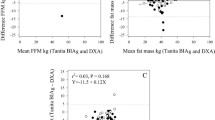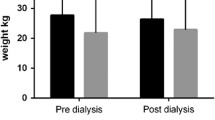Abstract
The detection, prevention and treatment of disease is greatly facilitated by the availability of accurate and non-invasive techniques for measuring the amount and regional distribution of fat mass and fat-free mass. As differing degrees of hydration may influence these measurements, we used dual-energy X-ray absorptiometry (DXA) and bioelectrical impedance analysis (BIA) to detect changes in hydration following hemodialysis, and to determine whether fat mass, fat-free mass and bone density measurements were affected by these fluid changes. Ten subjects (7 men, 3 women) mean age 46.2 years (range 25–68 years), with renal failure had bone density, fat-free mass and fat mass measured by DXA, and total body water and fat-free mass measured by BIA, before and after hemodialysis. Thirty-two subjects had fat-free mass measured by DXA and BIA in an attempt to derive new equations (using fat-free mass measured by DXA as the reference standard) to improve the predictive value of BIA. The new equations were then used to derive the changes in fat-free mass following hemodialysis measured using BIA. In absolute terms, total tissue measured by DXA (r=0.99,p=0.01) and total body water measured by BIA (r=0.91,p=0.01) correlated with gravimetric weight. Following hemodialysis, fat mass and bone density measured by DXA were unaffacted by the fluid changes. The change in gravimetric weight was 1.8±0.3 kg,p=0.01 (mean±SEM). This change was measured as 1.9±0.3 kg by DXA, −0.9±1.0 kg by BIA using the published equation for fat-free mass, and 3.2±0.4 kg using the new equation for fat-free mass. The change in fat-free mass measured by DXA (r=0.75,p=0.01), and the change in total body water measured by BIA (r=0.70,p=0.02), correlated with the change in gravimetric weight. The change in fat-free mass measured by BIA did not correlate with the change in gravimetric weight. With the new equation, the change in fat-free mass measured by BIA correlated with the change in gravimetric weight (r=0.74,p=0.02). We conclude that absolute values, and changes in fluid in the range observed in this study, can be detected reliably by DXA. They are reflected in the fat-free mass measurement and do not confound measurements of fat mass and bone density. Although absolute values are reliably measured by BIA, the technique may have limited usefulness in detecting fluid changes. DXA thus provides a practical, non-invasive, precise and accurate method of measuring body composition which can be used as a ‘gold standard’ for validating other techniques.
Similar content being viewed by others
References
Kuczmarski RJ. Need for body composition information in elderly subjects. Am J Clin Nutr 1989;50:115–7.
Shepherd RW, Holt TL, Greer R, Cleghorn GJ, Thomas BJ. Total body potassium in cystic flbrosis. J Pediatr Gastroenterol Nutr 1989;9:200–5.
Fedrix EWHM, Saris WHM, Soeters PB, Wouters EFM, Kester ADM, von Meyenfeldt MF, Westerterp KR. Estimation of body composition by bioelectrical impedance in cancer patients. Eur J Clin Nutr 1990;44:749–52.
Shizgal HM. Nutritional assessment with body composition measurements. JPEN 1987;11:S42–7.
Pi-Sunyer FX. Health implications of obesity. Am J Clin Nutr 1991;53:S159–603.
Haarbo J, Marslew U, Gotfredsen A, Christiansen C. Postmenopausal hormone replacement therapy prevents central distribution of body fat after menopause. Metabolism 1991;40:1323–6.
Bode S, Hassager C, Gudmand-Hoyer E, Christiansen C. Body composition and calcium metabolism in adult treated coeliac disease. Gut 1991;32:1342–5.
Schwartz RS, Shuman WP, Larson V, et al. The effect of intensive endurance exercise training on body fat distribution in young and older men. Metabolism 1991;40:545–51.
Binnerts A, Deurenberg P, Swart GR, Wilson JHP, Lamberts SWJ. Body composition in growth hormone-deficient adults. Am J Clin Nutr 1992;55:918–23.
Ley CJ, Lees B, Stevenson JC. Sex- and menopause-associated changes in body-fat distribution. Am J Clin Nutr 1992;55:950–4.
Sjostrom LV. Mortality of severely obese subjects. Am J Clin Nutr 1992;55:S516–23.
DeCossio TG, Diaz E, Delgado HL, Mendoza R, Gramajo L. Accuracy and precision of bioelectrical impedance analysis and anthropometry for estimating body composition. IPSM 3: in vivo body composition studies 1986. York, England: Institute of Physical Sciences.
Rayner HC, Stroud DB, Salamon K, et al. Anthropometry underestimates body protein depletion in haemodialysis patients. Nephron 1991;59:33–40.
Blanchard J, Conrad KA, Harrisom GG. Comparison of methods for estimating body composition in young and elderly women. J Geronto 1990;45:B119–24.
Newby MJ, Kein NL, Brown DL. Body composition of adult cystic fibrosis patients and control subjects as determined by densitometry, bioelectrical impedance, total-body conductivity, skinfold measurements and deuterium oxide dilution. Am J Clin Nutr 1990;52:209–13.
James HM, Fabricius PJ, Dykes PW. Measurement of whole body cellular and collagen nitrogen, potassium, and other elements by nitrogen activation and whole body counting. JPEN 1987;11:S48–50.
Cohn SH. In vivo neutron activation analysis. Med Phys 1981;8:145–55.
Deurenberg P, Weststrate JA, Hautvast JGAJ. Changes in fat-free mass during weight loss measured by bioelectrical impedance and by densitometry. Am J Clin Nutr 1989;49:336.
Lukaski HC. Methods for assessment of human composition: traditional and new. Am J Clin Nutr 1990;52:438–41.
Peppier WW, Mazess RB. Total body bone and lean body mass by dual-photon absorptiometry. I. Theory and measurement procedure. Calcif Tissue Int 1981;33:353–9.
Khaled MA, Cutcheon MJ, Reddy S, Pearman PL, Hunter GR, Weinsier RL. Electrical impedance in assessing human body composition: the BIA method. Am J Clin Nutr 1988;47:789–92.
Mazess RB, Peppier WW, Gibbons M. Total body composition by dual-photon (153Gd) absorptiometry. Am J Clin Nutr 1984;40:834–9.
Gotfredsen A, Jensen J, Borg J, Christiansen C. Measurement of lean body mass and total fat using dual photon absorptiometry. Metabolism 1986;35:88–93.
Hassager C, Sorensen SS, Nielsen B, Christiansen C. Body composition measurements by dual photon absorptiometry: comparison with body density and total potassium measurements. Clin Physiol 1989;9:353–60.
Heymsfield SB, Wang J, Heshka S, Kehayias JJ, Pierson R. Dual-photon absorptiometry: comparison of bone mineral and soft tissue mass measurements in vivo with established methods. Am J Clin Nutr 1989;49:1283–90.
Mazess RB, Barden HS, Bidek JP, Hanson J. Dual energy X-ray absorptiometry for total-body and regional bone mineral and soft tissue composition. Am J Clin Nutr 1990;51:1106–12.
Mazess RB, Peppier WW, Chestnut CH, et al. Total body bone mineral and lean body mass by dual-photon absorptiometry. II. Comparison with total body calcium by neutron activation analysis. Calcif Tissue Int 1981;33:361–3.
Hoffer EC, Meader CK, Simpson DC. Correlations of whole-body impedance with total body water. J Appl Physiol 1969;27:531–4.
Lukaski HC, Johnson PE, Bolonchuk WW, Lykken GI. Assessment of fat-free mass using bioelectrical impedance measurements of the human body. Am J Clin Nutr 1985;41:810–7.
Kushner RF, Schoeller DA. Estimation of total body water by bioelectrical impedance analysis. Am J Clin Nutr 1986;44:417–24.
Rising R, Swinburn B, Larson K, Ravussin E. Body composition in Pima Indians: validation of bioelectrical resistance. Am J Clin Nutr 1991;53:594–8.
Deurenberg P, Wetstrate JA, Van der Kooy K. Body composition changes assessed by bioelectrical impedance measurements. Am J Clin Nutr 1989;49:401–3.
Jebb SA, Ellia M. Assessment of changes in total body water in patients undergoing renal dialysis using bioelectrical impedance analysis. Clin Nutr 1991;10:81–4.
De Lorenzo A, Barra PFA, Sasso GF, Battistini NC, Deurenberg P. Body impedance measurements during analysis. Eur J Clin Nutr 1991;45:321–5.
Svendsen OL, Haarbo J, Heitmann BL, Gotfredsen A, Christiansen C. Measurement of body fat in elderly subjects using dual-energy X-ray absorptiometry, bioelectrical impedance, and anthropometry. Am J Clin Nutr 1991;53:1117–23.
Zillikens MC, OvandenBerg JW, Wilson JHP, Swart GR. Whole-body and segmental bioelectrical-impedance analysis in patients with cirrhosis of the liver: changes after treatment of ascites. Am J Clin Nutr 1992;55:621–5.
Lands LC, Heigenhauser GJF, Gordon C, Jones NL, Webber CE. Accuracy of measurements of small changes in soft tissue mass by use of dual-photon absorptiometry. J Appl Physiol 1991;71:698–702.
Author information
Authors and Affiliations
Rights and permissions
About this article
Cite this article
Formica, C., Atkinson, M.G., Nyulasi, I. et al. Body composition following hemodialysis: Studies using dual-energy X-ray absorptiometry and bioelectrical impedance analysis. Osteoporosis Int 3, 192–197 (1993). https://doi.org/10.1007/BF01623675
Received:
Accepted:
Issue Date:
DOI: https://doi.org/10.1007/BF01623675




